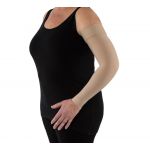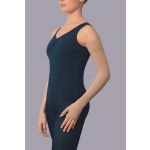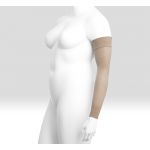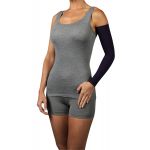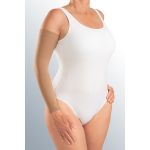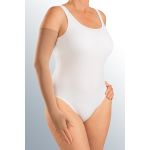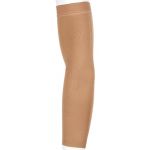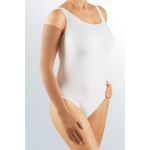Compression Arm Sleeves
Lymphedema Sleeves For Arms
Compression arm sleeves are a traditional means of providing compression and support to the arm in helping to manage and treat upper extremity Lymphedema but may also be used to treat phlebitis, during post-liposuction recovery and other healthcare conditions.
Shop our compression arm sleeves with pre-tax savings using your FSA or HSA account!
Lymphedema Sleeves For Arms
A compression arm sleeve is usually worn during the secondary or "maintenance" phase of Lymphedema treatment, after completion of complete decongestive therapy, or "CDT". Compression arm sleeves are made in a variety of lengths, sizes and colors, and are especially designed to fit the various anatomical structures of the arm. Most manufacturers also offer matching compression gloves and gauntlets that can be used along with the arm sleeve to provide complete upper extremity compression.
Compression arm sleeves are rated as to the amount of compression they apply, and it is important to choose the correct compression level that is required. Compression is measured in units referred to as millimeters of mercury or "mmHg", and should selected for treatment as follows.
While compression arm sleeves may be difficult to don and take off, there are an array of donning and doffing aids which will help the patient to easily use them. Also, be sure to protect your investment by using detergents that are specially formulated for compression garments.
You may also consider our RianCorp laser for lymphedema treatment (post-mastectomy) as an additional treatment alternative.
FAQs About Lymphedema Arm Sleeves
Below are some of the most frequently asked questions about compression arm sleeves for lymphedema.
Compression arm sleeves are snug-fitting garments worn over the arm to apply pressure evenly. Arm sleeves help promote the flow of lymph fluid out of the arm, which can reduce swelling and prevent fluid accumulation.
Compression arm sleeves work by providing graded compression, tightest at the wrist and gradually decreasing up the arm. This encourages lymph fluid to move towards the core of the body and back into the circulation system, which helps aid in the reduction of lymphedema symptoms.
Compression arm sleeves are most commonly used by people who have lymphedema or who are at risk of developing it (such as breast cancer survivors who have had lymph nodes removed).
There are different types of compression arm sleeves, with various materials, features, and compression levels. Some arm sleeves have moisture-wicking fabric, anti-microbial properties, and/or distinctive designs.
The compression level of an arm sleeve is measured in mmHg (millimeters of mercury) and should be selected based on the severity of lymphedema and the advice of your healthcare provider. Compression arm sleeves are available in different compression levels, typically ranging from light compression (15-20 mmHg) to firm compression (30-40 mmHg or higher).
It is generally safe to wear a compression sleeve during waking hours, but the arm sleeve should be removed at night, unless otherwise directed by your healthcare provider. There are special nighttime compression garments, which are specifically designed to provide support during the nighttime and during periods of low activity during the day.
Exercising while wearing a compression arm sleeve is often recommended, but you should check with your healthcare provider. The arm sleeve can help manage lymph flow during physical activity, which helps reduce the risk of increased swelling.
If your compression arm sleeve fits properly, it should not significantly restrict your range of motion. While your arm sleeve might feel snug, you should still be able to perform daily activities comfortably. If a sleeve extensively restricts movement, it might be too tight and/or improperly fitted.
Due to the snug fit of compression arm sleeves, they can be challenging to put on and take off. To put on an arm sleeve, using a specialized donning device or using a rubber glove can help you grip the fabric and more easily slide the sleeve up your arm. To take off your compression arm sleeve, gently roll the sleeve down your arm, taking care not to excessively tug or stretch the fabric.
We carry most brands of lymphedema compression arm sleeves, from some of the top manufacturers of lymphedema products including: Juzo, Jobst, Medi USA, Solaris, Sigvaris, LympheDivas, Solidea, Anita Care, and Therafirm.
Proper care of your compression arm sleeve can extend the life of the sleeve and help maintains its compressive properties. Wash your compression arm sleeve regularly following the manufacturer instructions (usually this involves hand washing and air-drying the sleeve).
The lifespan of a lymphedema compression arm sleeve depends largely on how frequently you use it and how well you care for it. In general, you should replace your compression arm sleeve every 4 to 6 months, since stretching and wear can reduce its effectiveness.
For more information about our compression arm sleeves for lymphedema, please call (800) 700-1032, or e-mail info@bandagesplus.com.
••••••••••••••••••••••••••••••••••••Medicare Pays For Lymphedema Products
Please note: Thanks to the Lymphedema Treatment Act, which took effect on January 1, 2024, Medicare began to pay for lymphedema products for those who have Medicare B coverage and meet certain other coverage criteria. Please visit our website page covering the details of the Lymphedema Treatment Act to obtain more information about how Medicare pays for lymphedema garments, wraps, and bandages


